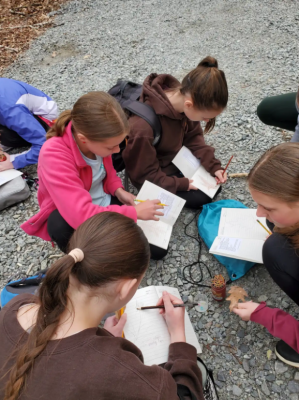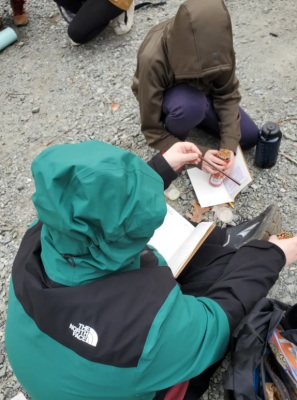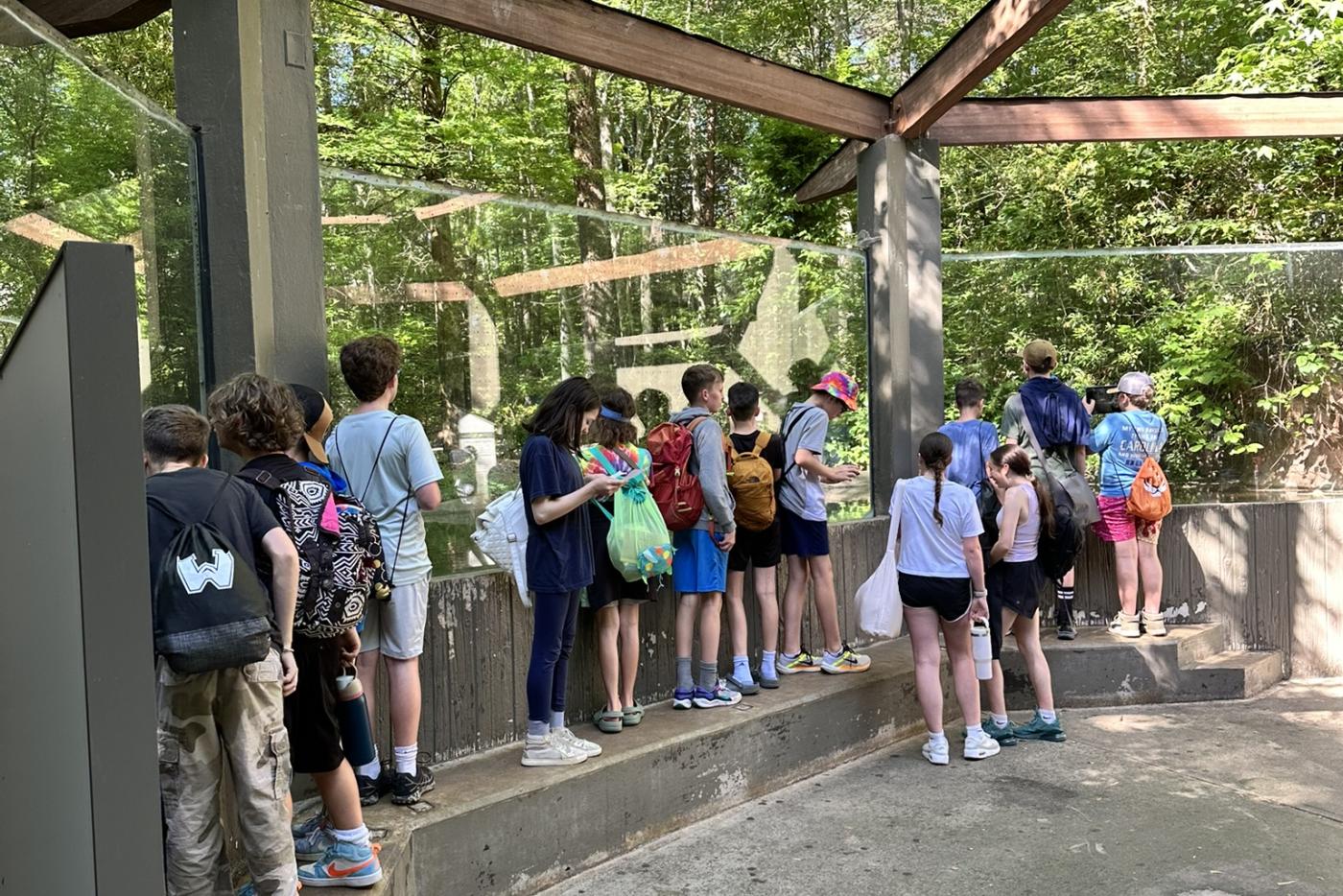Author: Allyson McFalls, 2025 DNCR Teacher Ambassador and 6th grade Science/ELA Teacher at the Blowing Rock School
Field trips have the power to change lives. I know that’s a bold statement, but it’s true.
As a six year old growing up in rural eastern North Carolina 35 years ago, there weren’t many opportunities for exciting field trips. But I remember my first grade teachers taking us to the Charles B. Aycock Birthplace. The excitement of choosing my outfit for the day, the bus ride with friends, and the general buzz that comes with a field trip, where you’re in school, but not in school. The day was filled with learning opportunities, from making homemade butter in tiny glass jars to walking in a circle with wicks, watching candles grow each time we dipped our wick in the large cast iron kettle over the outdoor fire. This was probably one of the first times I had experienced structured outdoor education at a state historical site, and I was hooked.
Since that time, I’ve had the chance to experience field trips through a different lens: that of a teacher trying to create magical, memorable experiences for my students. At this point in my career, 20 years in, I’ve probably planned and chaperoned well over 50 field trips, ranging from the monumental week-long trip to Washington, DC to those within our county and region like Elk Knob State Park and the Blue Ridge Parkway. Area art museums, the North Carolina Zoo, a career expo to the local hospital, a world renowned custom furniture factory, and a local bakery have all been on my list.

Planning a field trip is a daunting task for educators, and one that requires months of planning. Coordinating transportation (which is becoming increasingly more difficult with a shortage of bus drivers), adhering to county policies and communicating with administration regarding approval of trips, getting newsletters and permission forms sent out and signed, ensuring we have appropriate first aid and any medications students might need, and collaborating with school cafeteria staff to have school lunches for students all take time, often before or after school or during the weekends. If field trips are costly, we then have to consider funding for these trips.
I’ve been an advocate for field trips and outdoor education for my whole career, recognizing the value of these experiences for students. I also know that sometimes for some families, an ask of $20 for a field trip may as well be asking for $200. Many of these families would just rather their child not attend school that day, rather than have to request scholarship funds. Through participating in programs through NCDNCR such as Schools in Parks and Learning Happens Here Field Trip Fund, I’ve been able to secure grant funds that support phenomenal field trips for students, and alleviate the financial burden of costs to families.
This year, my teammate and I had planned our field trips for the year well before the school year started, beginning the planning process during our June workdays. We planned to visit Grandfather Mountain State Park in October, and the NC Zoo in May. Hurricane Helene had other plans for our region for the fall, and Grandfather Mountain State Park is still very much in recovery mode with limited full time staff on hand to support trail restoration. We were able to coordinate with Schools in Parks to transition our trip to Elk Knob State Park, and despite dreary, misty April weather, our students had a great time. The Schools in Parks representative who helped with our trip did a phenomenal job of leading our students through some leaf observation journaling, and a tree identification hike. I had the joy of seeing students who typically fade into the background in a classroom setting light up outdoors. Suddenly, their generational and family traditions of gardening, hunting, and living close to the land were areas of expertise for them, and not something to be diminished. They were quite literally the experts on the mountain, and were able to contribute so much to the conversation. Kids who spend so much time indoors and on screens were encouraged to observe closely, listen carefully, and find new magic in the natural world around them. There was newfound joy in an emerging spring flower, fascination at the burls on trees, laughter with friends as they hiked the trail.

Our trip to the NC Zoo was a highlight of the year for our students. We’re grateful for the NCDNCR Learning Happens Here Field Trip Fund, which helped to fund our transportation by charter bus, making the three hour trip much more enjoyable and alleviated some stress of finding a driver. My students have practiced using nature journaling throughout the spring semester, and they are adept at using their journals in a variety of outdoor locations. They took their nature journals and water color pencils, and with their small groups, found a location where they could make an entry in their journal. Each student had the opportunity to select some wish list animals they wanted to see, and we ensured that they all got to see animals on their lists. Students were in awe of the giraffes, African wildlife, baboons, and orangutans. The desert wildlife was also a favorite spot, and many were enthralled by the desert cat. They were amazed at the size of the exhibits, and many were truly grateful to see animals in habitats that were so similar to their native ones.
One student said, in a reflection following the field trip, “I think our North Carolina Zoo trip was amazing, it was really cool seeing all the different types of wild animals that I would not be able to see just in my backyard. My favorite animal was probably the gorilla exhibit since there were multiple and one of the gorillas came right up to the glass. I also really liked the giraffe board walk that you had to spend $5 because you got to feed the giraffes and see them really up close. I would want to do a safari ride through one of the African exhibits so I could see them up close.”
Field trips are certainly additional work for educators to organize and fund, but its experiences like these for students that will stick with them for a lifetime. It’s why we became teachers in the first place; to make an impact today that will carry with students into the future. We never know where the experiences we give them will take them, but it’s nice to know that we’ve made an impact both inside and outside the classroom.
Allyson's Recommended Resources
Field Trips at NC State Parks
Schools in Parks
NC Kids' Exploration Journals
DNCR Field Trip Fund
Educational Resources at the NC Zoo
About the Author:
Allyson McFalls is a 20 year veteran North Carolina teacher, having taught middle school science and ELA for her entire career. She is a National Board Certified Teacher, and holds a masters degree in library science. She recently was selected as an Educator of Excellence and went to Yellowstone National Park with 12 other NC educators and staff from the NC Museum of Natural Sciences. She has a passion for education, and for engaging students in outdoor learning experiences and independent science research projects. Allyson was a North Carolina Teaching Fellow at Appalachian State University and is now grateful to call Boone home, where she lives with her husband and boys.

